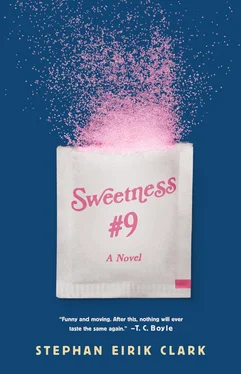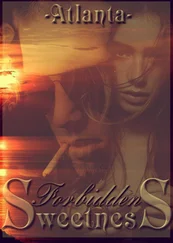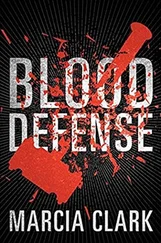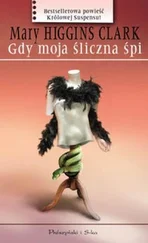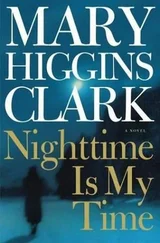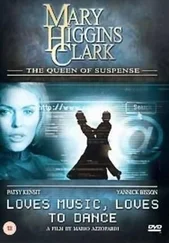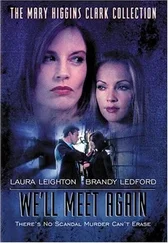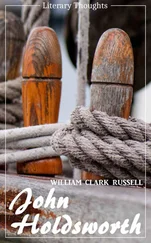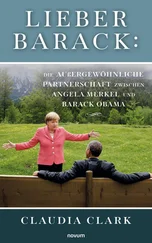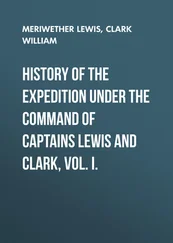He drank his coffee.
I pointed at his cup. “I thought you were a sugar man?”
He glanced at the design of his torn packet and only then realized what he’d done. “It’s so easy to get them confused.” He set a packet of sugar down beside the one he’d used. Both white, they looked almost identical. “Was so much easier when the contents were pink.”
“Well, you should be more careful. As Priscilla’s readers will soon know”—and my voice grew ominous here—“Sweetness #9 leads to obesity, apathy, anxiety, and a forgetfulness that verges on panic.”
My intent was comic, but he seized on that last symptom, saying he felt the need to apologize again for requiring my help the previous day.
“I used to know how to drive to Edison.” He shook his head. “But now… well, you’ll have to be kind to me when I come down with Alzheimer’s.”
“Don’t talk such nonsense. You got turned around, is all.”
“Let’s hope. I had a friend who came down with the disease. Died a couple of years ago.”
“Alzheimer’s?”
He nodded. “Man couldn’t remember what he’d had for breakfast, but he’d talk about the distant past as if it were happening before his eyes.” He spoke down into his cup, smiling at the memory. “He crashed my car in the late sixties, one weekend when his own was in the shop. “This was not long after Eliza left me,” he said. “It was one of the last great Cadillacs. If Noah had driven, he would’ve driven this car. I only bought it so I could go through the Holland Tunnel on the weekends.” He looked up, telling me American women won’t date a man who insists on public transportation. “At least that was the case when I still worried about such things.”
He chewed on a piece of bread and cheese, then continued. “That car couldn’t have had more than two thousand miles on it when he drove it into a tree. He was coming back from a romantic rendezvous on the Jersey Shore. Said a deer ran out in front of him.”
He swatted at the air. “Years passed. I all but forgot. Then I sit down at his bedside near the end and he starts telling me the story again, this time with a different ending. There was no deer. There was an Italian woman with her head in his lap and a pothole that made her bite.” He chuckled. “When they tumbled out, bloody and embarrassed, he was lucky it was only the car that was totaled.”
The cuckoo clock over the door chimed the hour. He waited for it to finish before doing so himself. “Can you think of anything worse? Cancer may slowly kill you, but only Alzheimer’s has the power to reveal all of your lies.”
We ate for another ten or fifteen minutes after that, but our conversation had stalled. We both seemed to be elsewhere, our minds adrift. Finally, I looked at my watch and asked him if he was coming into the office.
“No, maybe tomorrow,” he said.
“Well, I had better get going. Leave Beekley alone too long and he’s liable to burn the place down, isn’t he?”
* The river caught fire in 1971, but as this was two years after the Cuyahoga did the same, it only made the local and regional news.
A LITTLE BEFORE LUNCH THAT DAY, Beekley appeared in the doorway to the flavor development studio. He didn’t enter the lab, though; he just stood there, tapping a rolled-up copy of Food Technology magazine against his leg.
Knowing he wanted our attention, I did my best to ignore him. “Now, after you’ve done that,” I told Koba, who stood across from me at his work station, “I want you to find two chemicals that occur naturally in and characterize the flavor of apples, then locate those chemicals that could make them riper, sweeter, and juicier.”
Koba jotted all of this down in his notebook, though without his usual powers of concentration. His eyes kept flitting over to the door.
Like so many men of his generation, Beekley threw all of his loose change at the Salvation Army, dressing not to show people who he was but rather who he wasn’t. Today he looked like he worked in a video store: a pair of coarse khakis, a white A-frame undershirt (“a wife-beater,” he insisted on calling it), and a short-sleeve button-up paisley shirt whose flared collars could’ve poked an eye out.
“All right,” I said. “What is it? An earthquake drill?”
“Everyone needs to come with me,” he announced.
“Where to?” Koba said.
Beekley shook his head. “Can’t say. Just come. I have something very important to show you.”
I wasn’t about to follow him anywhere, and not only because I feared he might want to drive us in the orange van he’d bought earlier in the year — a vehicle that had come complete with a tinted bubble window and now, after several costly “improvements,” boasted floor-to-ceiling carpeting and a bed in back. No, it wasn’t just the journey I wanted to avoid, it was the destination. Beekley was our resident collector of obsolete technology. He had a reel-to-reel high-fidelity system at home, a rotary phone, and plans for a dark-room; he even boasted of getting all his pornographic needs met by nudist magazines of the early 1950s. In short, he’d done this sort of thing before, and just as often as not, he had nothing more significant to show us than a stack of Nude Living magazines he’d found at the Goodwill or a Star Wars figure still in its box.
“I’ll bite,” Tennessee said, as Beekley turned out the door.
“You can’t be serious?” I said. Koba was looking to me for direction.
“C’mon, David.” Tennessee slapped me on the back as he passed. “You took the morning off. The least we can do is give this gentle fool a few minutes of our time.”
If the redevelopment process in downtown Battle Station began when Mayor Higgins sank a golden shovel into the plot of dirt now occupied by the Hilton, its logical conclusion came in 1994, when the Stupfer Bridge, the now celebrated Stupfer Bridge, had one of its three lanes of traffic closed off to automobiles — a very controversial decision at the time — so that the “historic city centre” (as the signs read) could appear more pedestrian-friendly.
Almost immediately, scores of local residents were flocking to the bridge on the weekends to jog or stroll or show their civic pride in Spandex shorts and a pair of Rollerblades. I, too, often traversed this span, if not to meet Betty for lunch, then simply so I could pop into a bookstore to buy a grande cappuccino or browse the latest Stephen King. That all of this could be done on a corner where once you could have bought (or so it is said) a rock of crack cocaine never ceased to thrill me, at least until that summer of 1998, when a farmer’s market appeared beneath the shadows of the bridge. Then, feeling as you do when you arrive at a party and realize you’re the oldest one there, I found myself driving on my lunch hour into those parts of the city that my daughter considered “more authentic,” where the Chinese restaurants had paper tablecloths and napkins, and you could walk into a corner liquor store and find cigarettes sold at the front counter for a quarter apiece. I’m not sure I was even conscious of what I was resisting, but I do know when it was that I toured the farmer’s market stalls for the first time: that day when Beekley led us out of the office, saying there was something we had to see.
“You can’t tell us where we’re going?” Koba said, after we had moved up onto the Stupfer Bridge and heard Beekley remind us of just that. “Why can’t you say where we’re going?”
“If I told you,” Beekley said, “I might as well tell you. Now just bear with me. You’ll understand soon enough.”
“It’s the farmer’s market,” I said to the others. “He thinks he’s going to tell us something we don’t know about America by pointing out the crooked carrots and the overpriced tomatoes. It’s a craze, I know. Sweeping the nation. Everyone wants to talk to the farmer who grew their potatoes and make sure he’s got dirt beneath his fingernails.”
Читать дальше
